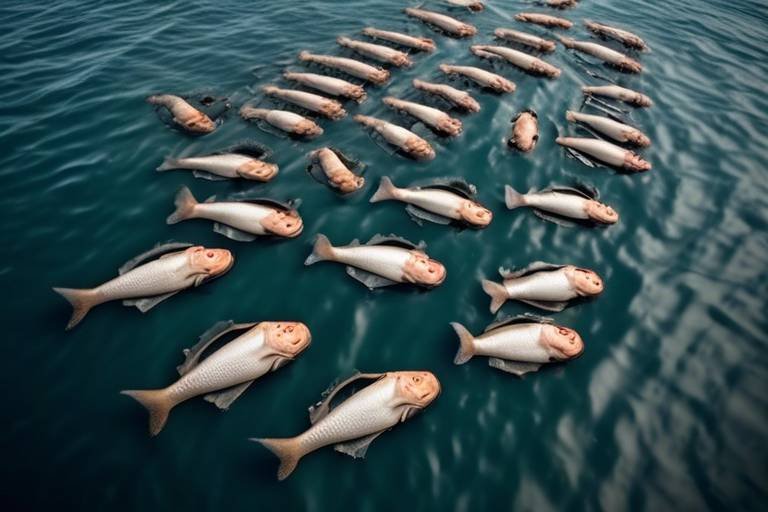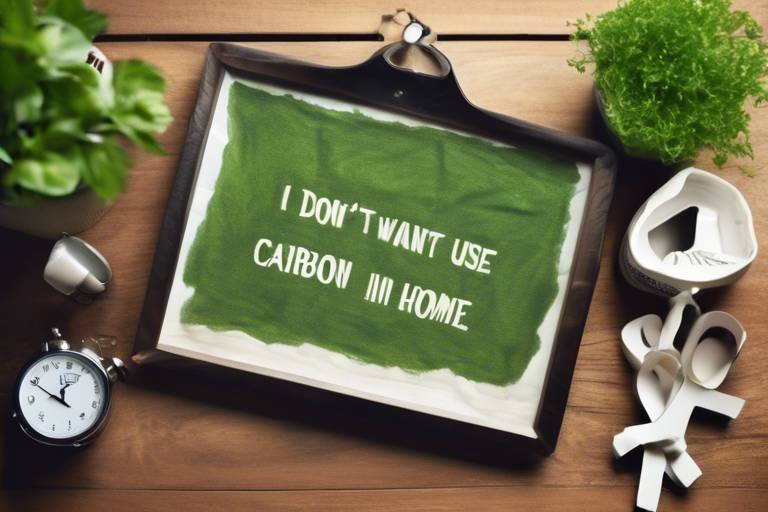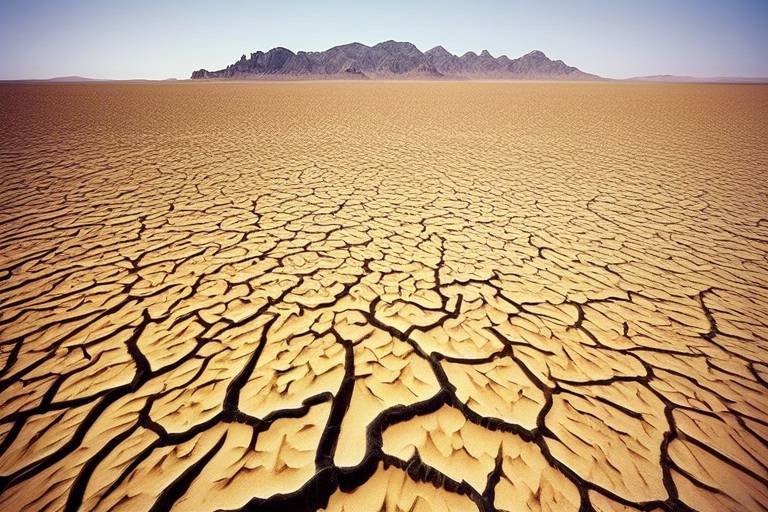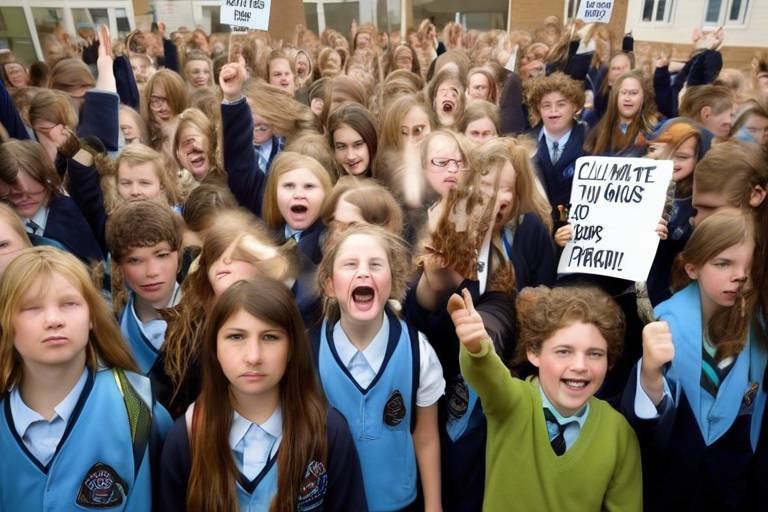The Link Between Synthetic Fibers and Microplastic Pollution
The world we live in today is increasingly dominated by synthetic fibers—the unsung heroes of modern fashion. These materials, like polyester and nylon, have become staples in our wardrobes, providing durability, flexibility, and affordability. However, as we embrace these conveniences, we often overlook a pressing issue: the profound connection between synthetic fibers and the growing crisis of microplastic pollution in our environment. This article will delve into this connection, exploring how our clothing choices impact the planet and what we can do to mitigate these effects.
When we think about pollution, we often picture smoke stacks or plastic bags clogging our oceans. But what about the invisible threats lurking in our water? Microplastics—tiny plastic particles less than 5mm in size—have infiltrated every corner of the globe, from the deepest ocean trenches to the most remote mountain ranges. They come from various sources, but a significant contributor is the washing of synthetic textiles. Every time we toss our favorite polyester shirt into the washing machine, we inadvertently release countless microfibers into the water system, which can eventually make their way into our oceans and food chains.
But why should we care? The consequences of microplastic pollution are dire. It's not just marine life that suffers; these tiny particles can also have serious implications for human health. When fish and other seafood ingest microplastics, they can accumulate in their bodies, and when we consume these creatures, we too become part of the problem. Moreover, the ecological impact is staggering, affecting biodiversity and disrupting entire ecosystems. The question then arises: how do we tackle this issue?
As awareness of this crisis grows, so does the response from governments and organizations around the world. Regulatory measures are being put in place to combat microplastic pollution, focusing on reducing the release of synthetic fibers. Some countries are even considering bans on certain plastic products and promoting sustainable alternatives. Yet, while these initiatives are crucial, they are just the tip of the iceberg. We must also consider our role as consumers and the choices we make every day.
In conclusion, the link between synthetic fibers and microplastic pollution is undeniable and multifaceted. As we continue to enjoy the benefits of synthetic textiles, it is imperative that we also take responsibility for their impact on our environment. By understanding the consequences of our clothing choices, advocating for better regulations, and embracing innovative solutions, we can work towards a more sustainable future. The question remains: will we act before it's too late?
- What are synthetic fibers? Synthetic fibers are man-made materials, such as polyester and nylon, commonly used in textiles.
- How do synthetic fibers contribute to microplastic pollution? When washed, synthetic garments release microfibers that can enter waterways and ecosystems.
- What are the environmental impacts of microplastics? Microplastics can harm marine life, disrupt ecosystems, and pose health risks to humans through the food chain.
- What can consumers do to reduce microplastic pollution? Consumers can choose natural fibers, wash clothes less frequently, and support brands that prioritize sustainability.
- Are there any regulations in place to combat microplastic pollution? Yes, various governments are implementing regulations to reduce plastic waste and promote sustainable practices.

Understanding Synthetic Fibers
Synthetic fibers, such as polyester and nylon, have become the backbone of the modern textile industry. Their popularity can be attributed to a variety of factors, including their durability, versatility, and cost-effectiveness. Unlike natural fibers, which are derived from plants or animals, synthetic fibers are created through chemical processes that involve the polymerization of petrochemicals. This means that they are not only strong but also resistant to wrinkles, mildew, and shrinking, making them an attractive option for both manufacturers and consumers alike.
The production process for synthetic fibers is fascinating yet complex. It begins with the extraction of crude oil, which is then refined into various chemicals. These chemicals undergo a series of reactions to form long chains of polymers. The resulting fibers can be spun into threads, woven or knitted into fabrics, and dyed in a myriad of colors. This versatility allows for a wide range of applications—from everyday clothing to high-performance athletic wear. In fact, the global market for synthetic fibers has seen exponential growth, with polyester alone accounting for over 50% of the total fiber market.
So, why are synthetic fibers so popular in our clothing? Here are some compelling reasons:
- Affordability: Synthetic fibers are generally cheaper to produce than natural fibers, making them more accessible to consumers.
- Performance: Many synthetic fibers are engineered for specific functions, such as moisture-wicking or UV protection, which enhances their appeal for activewear.
- Variety: The ability to create a vast range of textures, colors, and finishes means that synthetic fabrics can mimic the look and feel of natural materials while offering additional benefits.
However, while synthetic fibers offer numerous advantages, they also come with significant downsides. The most pressing issue is their environmental impact, particularly in relation to microplastic pollution. As we delve deeper into this topic, it’s essential to recognize that the convenience and affordability of synthetic fabrics come at a cost that we can no longer afford to ignore.
In summary, synthetic fibers have revolutionized the clothing industry by providing durable, versatile, and cost-effective options for consumers. Yet, as we embrace these innovations, we must also consider the environmental ramifications that accompany their widespread use. Understanding the intricate balance between the benefits and drawbacks of synthetic fibers is crucial as we move forward in addressing the pressing issue of microplastic pollution.

Microplastics Defined
Microplastics are defined as tiny plastic particles that measure less than 5mm in size. These minuscule bits of plastic have become a pervasive issue in our environment, infiltrating ecosystems and even our own bodies. You might be wondering, how do these tiny particles come into existence? Well, they can form in a variety of ways, primarily through the breakdown of larger plastic items, such as bottles, bags, and other waste. As these larger plastics degrade due to environmental factors like sunlight and wave action, they fragment into smaller pieces, ultimately becoming microplastics.
Additionally, microplastics are not just a byproduct of plastic waste. They are also intentionally manufactured for use in various products. For instance, microbeads found in personal care items like exfoliating scrubs and toothpaste are a direct source of microplastic pollution. When these products are washed down the drain, they enter our waterways, contributing to the growing problem of microplastic contamination.
The environmental challenges posed by microplastics are staggering. They are not only found in oceans but also in rivers, lakes, and even the air we breathe. Once microplastics enter these ecosystems, they can have detrimental effects on marine life. Fish and other aquatic organisms often mistake these particles for food, leading to ingestion that can harm their health and ultimately disrupt the food chain. Furthermore, microplastics can absorb harmful chemicals from the water, which can then be transferred to the organisms that consume them, creating a dangerous cycle of pollution.
To illustrate the scale of the problem, consider the following table that highlights the sources and environmental impact of microplastics:
| Source of Microplastics | Environmental Impact |
|---|---|
| Synthetic textiles | Release of microfibers into water systems during washing |
| Personal care products | Microbeads entering waterways |
| Industrial processes | Accidental release of plastic particles |
| Degradation of larger plastics | Fragmentation leading to widespread pollution |
As we delve deeper into this issue, it becomes clear that microplastics are not just a nuisance; they represent a significant environmental challenge that requires urgent attention. The more we understand about their origins and impact, the better equipped we will be to tackle this growing problem and protect our planet.
- What are microplastics? Microplastics are tiny plastic particles less than 5mm in size, often resulting from the breakdown of larger plastic items or manufactured for specific uses.
- How do microplastics enter the environment? They can enter the environment through various sources, including washing synthetic textiles, personal care products, and the degradation of larger plastic waste.
- What are the effects of microplastics on marine life? Marine organisms can ingest microplastics, which can harm their health and disrupt the food chain.
- What can be done to reduce microplastic pollution? Solutions include using natural fibers, improving waste management, and raising consumer awareness about the impact of plastic products.

Sources of Microplastics
Microplastics are everywhere, and their origins are as varied as the colors in a rainbow. One of the most significant contributors to this growing pollution crisis is synthetic textiles. When we think of our favorite clothes, many of them are made from polyester, nylon, and other synthetic fibers. These materials, while popular for their durability and affordability, are notorious for shedding tiny plastic fibers during washing. In fact, studies suggest that a single wash of synthetic garments can release thousands of microfibers into our wastewater systems, which ultimately end up in rivers, lakes, and oceans.
But synthetic textiles are not the only culprits in this environmental drama. Microplastics also come from a variety of sources, including:
- Personal Care Products: Items like exfoliating scrubs, facial cleansers, and toothpaste often contain microbeads, which are tiny plastic particles designed to enhance texture. These beads wash down the drain and contribute to the microplastic problem.
- Industrial Processes: Manufacturing processes that involve plastics can release small particles into the environment. This includes everything from the production of plastic products to the breakdown of larger plastic items.
- Wear and Tear: As synthetic materials are used, they naturally degrade over time. This wear and tear can lead to the release of microplastics into the environment, even when the items are not being washed.
To put this into perspective, a recent report indicated that up to 35% of all microplastics in the ocean come from the washing of synthetic textiles. This staggering statistic highlights the need for urgent action and awareness. The problem is compounded by the fact that microplastics are incredibly persistent in the environment, taking hundreds of years to decompose. They can accumulate in marine life, entering the food chain and posing risks not only to wildlife but also to human health.
In summary, while synthetic textiles are a significant source of microplastics, they are not alone. From personal care products to industrial waste, microplastics are a complex issue that requires a multifaceted approach to tackle effectively. As we continue to explore the sources of microplastics, it becomes increasingly clear that addressing this problem will involve changes at both the consumer and industrial levels.

Washing Machine Impact
When we toss our favorite synthetic garments into the washing machine, we often overlook an alarming consequence: the release of microfibers into our wastewater. Each wash cycle can shed thousands of these tiny plastic strands, which are less than 5mm in size, contributing significantly to the microplastic pollution crisis. It's astonishing to think that something as routine as doing laundry could have such profound environmental implications!
To put it into perspective, a single load of laundry can release up to 700,000 microfibers into the water system. That’s like sending a small plastic bottle's worth of microplastics into our rivers, lakes, and oceans with every wash! These microfibers originate from popular synthetic fibers like polyester and nylon, materials that are favored for their durability and low cost. However, this durability comes at a price, as it means they don’t biodegrade easily, leading to long-term pollution.
One of the primary culprits in this process is the washing machine itself. The agitation and friction during a wash cycle cause these fibers to break free from the fabric. While some of these microfibers are captured by wastewater treatment facilities, a significant portion escapes into our waterways, eventually making their way to the ocean. Here, they can be ingested by marine life, leading to a cascade of ecological consequences.
So, what can we do to mitigate this issue? Here are a few strategies:
- Use a Guppyfriend bag: This special laundry bag captures microfibers during washing, preventing them from entering the wastewater.
- Wash less frequently: Reducing the number of times we wash synthetic clothing can significantly decrease microfiber release.
- Opt for front-loading machines: These machines tend to be gentler on fabrics and can reduce the amount of microfiber shed.
As consumers, we hold the power to influence change. By being mindful of our laundry practices, we can take a stand against microplastic pollution. It's crucial to remember that every small action counts, and together, we can make a significant difference in preserving our environment for future generations.

Environmental Consequences
The release of microplastics into our ecosystems is not just a minor inconvenience; it’s a ticking time bomb for our planet. When synthetic fibers break down, they don’t just vanish; instead, they fragment into tiny particles that infiltrate our waterways, soil, and even the air we breathe. These microplastics, often less than 5mm in size, pose a significant threat to wildlife and biodiversity. Imagine a tiny fish mistaking a microplastic for food—this scenario is becoming increasingly common, leading to dire consequences for marine life.
Microplastics have been found in the stomachs of various marine animals, from fish to seabirds, and this ingestion can cause serious health issues. For instance, these particles can lead to malnutrition, as they fill the stomachs of animals without providing any nutritional value. Moreover, the toxins associated with microplastics can accumulate in the tissues of these creatures, creating a ripple effect up the food chain. This means that larger predators, including humans, can end up consuming these harmful substances. The thought of consuming seafood that has ingested microplastics is alarming, isn’t it?
Furthermore, the presence of microplastics in the environment disrupts the delicate balance of ecosystems. They can affect the growth and reproduction of various species, leading to declines in populations. For example, studies have shown that microplastics can hinder the development of coral reefs, which are vital to marine biodiversity. Without healthy coral reefs, entire ecosystems can collapse, leading to a loss of habitat for countless marine species.
Additionally, microplastics can alter the physical and chemical properties of the habitats they invade. For instance, they can affect the quality of water and soil, leading to reduced agricultural productivity and compromised drinking water sources. This is particularly concerning in regions where communities rely heavily on local water sources for their livelihoods.
To illustrate the magnitude of this issue, consider the following table that summarizes the environmental impacts of microplastics:
| Impact | Description |
|---|---|
| Wildlife Ingestion | Microplastics are ingested by marine animals, leading to malnutrition and health problems. |
| Toxicity Accumulation | Microplastics can carry harmful chemicals that accumulate in the food chain. |
| Ecosystem Disruption | Microplastics can affect growth and reproduction in marine species, leading to population declines. |
| Habitat Alteration | Microplastics can change the chemical and physical properties of water and soil. |
In summary, the environmental consequences of microplastic pollution are profound and far-reaching. It’s not just an issue for marine life; it’s a problem that has implications for human health and the sustainability of our planet. As we continue to grapple with the effects of synthetic fibers and microplastics, it becomes increasingly clear that we must take action to mitigate these impacts. The question remains: how long can we ignore this pressing issue before it’s too late?
- What are microplastics? Microplastics are tiny plastic particles less than 5mm in size that originate from various sources, including synthetic textiles.
- How do synthetic fibers contribute to microplastic pollution? Synthetic fibers shed microplastics during washing and wear, which are then released into waterways.
- What are the health risks associated with microplastics? Microplastics can accumulate in the food chain, posing potential health risks to humans and wildlife.
- What can be done to reduce microplastic pollution? Solutions include using natural fibers, implementing better filtration systems in washing machines, and supporting regulations aimed at reducing plastic use.

Regulatory Responses
The growing awareness of microplastic pollution has prompted governments and organizations worldwide to take a stand. With synthetic fibers being a major contributor to this issue, regulatory responses are becoming increasingly vital. Many countries are now implementing measures aimed at curbing the release of microplastics into the environment, particularly from the textile industry. These regulations often focus on the entire lifecycle of synthetic fibers, from production to disposal.
For instance, the European Union has proposed stringent regulations that target microplastic pollution directly. One of the key initiatives is the EU Plastics Strategy, which aims to reduce plastic waste and promote sustainable alternatives. Under this strategy, the EU is considering bans on certain types of microplastics and encouraging manufacturers to adopt more environmentally friendly practices. This includes the use of biodegradable materials and the development of textiles that shed fewer microfibers during washing.
Furthermore, several countries have started to introduce mandatory filtration systems in washing machines. These systems are designed to capture microfibers before they enter wastewater systems. For example, in France, legislation has been passed requiring all new washing machines to be equipped with such filters by 2025. This proactive approach is a significant step in mitigating the impact of synthetic fibers on our ecosystems.
In addition to national regulations, various organizations and NGOs are advocating for change at the grassroots level. They are working to raise awareness about the issue and pushing for voluntary commitments from brands to reduce their microfiber output. This includes initiatives like the “Ocean Clean Wash” campaign, which encourages consumers to choose brands that prioritize sustainability and less harmful production methods.
To illustrate the current landscape of regulatory responses, here’s a brief overview of some notable initiatives:
| Region | Regulation/Initiative | Description |
|---|---|---|
| European Union | EU Plastics Strategy | Aims to reduce plastic waste, including microplastics from textiles. |
| France | Washing Machine Filter Law | Mandatory filters in new washing machines by 2025 to capture microfibers. |
| United States | Microbead-Free Waters Act | Bans the use of microbeads in personal care products, indirectly addressing microplastic pollution. |
While these regulatory measures are a step in the right direction, they are just the beginning. The challenge lies in enforcing these regulations and ensuring compliance among manufacturers. Additionally, there is a pressing need for international cooperation, as microplastic pollution is a global problem that transcends borders. Without a unified approach, efforts to combat this issue may fall short.
In conclusion, regulatory responses to microplastic pollution, particularly from synthetic fibers, are gaining momentum. While progress has been made, continued advocacy, consumer awareness, and innovative solutions will be essential in driving change. It’s not just about regulations; it’s about creating a culture of sustainability that prioritizes the health of our planet.
- What are microplastics? Microplastics are tiny plastic particles less than 5mm in size, often originating from synthetic textiles and other sources.
- How do synthetic fibers contribute to microplastic pollution? When synthetic garments are washed, they release microfibers into wastewater, which can eventually enter oceans and waterways.
- What regulations are in place to combat microplastic pollution? Various countries, including those in the EU, have implemented regulations such as mandatory washing machine filters and bans on specific microplastics.
- How can consumers help reduce microplastic pollution? Consumers can choose sustainable clothing options, support brands that prioritize eco-friendly practices, and be mindful of their washing habits.

Innovative Solutions
As the world increasingly acknowledges the pressing issue of microplastic pollution, innovative solutions are emerging that aim to tackle this environmental crisis head-on. One of the most exciting developments is the rise of sustainable textiles. These are materials that are designed not only to reduce waste but also to minimize the environmental impact throughout their lifecycle. For instance, brands are experimenting with bio-based fibers derived from natural sources, such as hemp, organic cotton, and even recycled plastics. By utilizing these materials, the textile industry can significantly decrease its reliance on synthetic fibers, thereby reducing the overall microplastic output.
Another groundbreaking approach involves the use of advanced filtration systems in washing machines. These systems are designed to capture microfibers before they enter the wastewater stream. Imagine a washing machine that acts like a mini water treatment plant, filtering out harmful particles and ensuring that only clean water is released back into the environment. Some manufacturers are already implementing this technology, and it has the potential to dramatically reduce the number of microplastics that make their way into our oceans.
Furthermore, there is a growing emphasis on consumer education. By informing the public about the environmental impact of synthetic fibers, consumers can make more conscious choices when purchasing clothing. For example, opting for brands that prioritize sustainable practices or choosing second-hand clothing can significantly decrease the demand for new synthetic textiles. This shift in consumer behavior can create a ripple effect, encouraging manufacturers to adopt more environmentally friendly practices.
Moreover, some companies are pioneering the use of biodegradable plastics in their textile production. These materials break down naturally over time, unlike traditional plastics which can linger in the environment for hundreds of years. The adoption of biodegradable options could revolutionize the industry, making it possible to enjoy the benefits of synthetic fibers without the long-term environmental consequences.
In addition, collaborative initiatives between governments, NGOs, and the textile industry are crucial in addressing this issue. By working together, these entities can develop comprehensive strategies that not only aim to reduce microplastic pollution but also promote a circular economy within the textile sector. This could involve implementing stricter regulations on the production and disposal of synthetic textiles, as well as providing incentives for companies that adopt sustainable practices.
To summarize, innovative solutions to combat microplastic pollution are not just a dream; they are already being put into action. With advancements in sustainable materials, improved washing technology, and heightened consumer awareness, we have the tools to make a significant impact. However, it requires collective effort and commitment from all stakeholders involved to ensure a cleaner, healthier planet for future generations.
- What are synthetic fibers? Synthetic fibers are man-made materials, such as polyester and nylon, commonly used in clothing and textiles.
- How do synthetic fibers contribute to microplastic pollution? When washed, synthetic garments shed tiny plastic fibers that enter the water system, contributing to microplastic pollution.
- What are some solutions to reduce microplastic pollution? Solutions include using sustainable textiles, installing filtration systems in washing machines, and increasing consumer awareness about clothing choices.
- Are there biodegradable alternatives to synthetic fibers? Yes, some companies are developing biodegradable plastics that can serve as alternatives to traditional synthetic fibers.

Consumer Awareness
In today's fast-paced world, where fashion trends change as quickly as the seasons, the importance of cannot be overstated. With the rise of synthetic fibers in our clothing, it's crucial for consumers to understand the impact of their choices on the environment. Did you know that every time you wash a synthetic garment, it sheds tiny plastic fibers that contribute to microplastic pollution? This is a reality that many people are unaware of, yet it has profound implications for our planet.
When consumers become informed about the environmental footprint of their clothing, they can make better choices that align with their values. For instance, opting for natural fibers like cotton, wool, or linen can significantly reduce the amount of microplastics released into the water system. But how do we encourage this shift in mindset? Education is key. By raising awareness through campaigns, workshops, and social media, we can empower individuals to consider the consequences of their purchases.
Moreover, understanding the lifecycle of clothing—from production to disposal—can help consumers make more sustainable choices. Here are a few important points to consider:
- Research Brands: Look for companies that prioritize sustainability and transparency in their production processes.
- Choose Quality Over Quantity: Investing in high-quality garments that last longer reduces waste and the frequency of washing.
- Support Second-Hand Shopping: Thrift stores and online resale platforms offer a sustainable alternative to fast fashion.
By embracing these practices, consumers can play a pivotal role in reducing the demand for synthetic fibers and, consequently, the microplastic pollution that accompanies them. It's not just about personal choice; it's about contributing to a larger movement towards sustainability. As more individuals make conscious decisions, we can collectively push the textile industry towards more responsible practices.
In conclusion, consumer awareness is the catalyst for change. When we understand the ripple effects of our clothing choices, we can drive demand for sustainable alternatives that protect our environment for future generations. So, the next time you're shopping, ask yourself: What impact does this garment have on our planet? Your choices matter, and they can help shape a more sustainable future.
Q: What are synthetic fibers?
A: Synthetic fibers are man-made materials, such as polyester and nylon, commonly used in clothing production.
Q: How do synthetic fibers contribute to microplastic pollution?
A: When washed, synthetic garments release tiny plastic fibers into wastewater, which can enter water bodies and harm marine life.
Q: What can consumers do to reduce microplastic pollution?
A: Consumers can choose natural fibers, buy second-hand clothing, and support brands that prioritize sustainability.
Q: Are there any regulations on microplastic pollution?
A: Yes, various governments and organizations are implementing regulations to address microplastic pollution, including initiatives to reduce synthetic fiber waste.

Future of Textiles
The future of textiles is not just about fabric; it’s about the fabric of our society and how we choose to interact with our environment. As we stand at a crossroads, the textile industry is experiencing a transformative shift towards sustainability and innovation. With increasing awareness of the environmental impact of synthetic fibers, designers, manufacturers, and consumers are seeking alternatives that promote ecological responsibility. Imagine a world where your favorite shirt not only looks good but also contributes positively to the planet. That’s the vision driving the evolution of textiles today.
One of the most promising trends is the rise of biodegradable materials. These fabrics, derived from natural sources such as organic cotton, hemp, and even innovative materials like pineapple leaves and orange peels, are designed to break down naturally without leaving harmful residues. This shift away from traditional synthetic fibers can significantly reduce the volume of microplastics entering our ecosystems. In fact, it’s estimated that switching to biodegradable textiles could decrease microplastic pollution by a staggering percentage over time.
Moreover, technological advancements in textile production are paving the way for a more sustainable future. Innovations like 3D knitting and digital printing not only minimize waste but also allow for greater customization and efficiency. These methods can produce garments on demand, reducing the need for mass production and the associated waste. Imagine being able to order a shirt that fits you perfectly, made just for you, without the excess fabric that typically ends up in landfills. This is not just a dream; it’s becoming a reality.
Furthermore, the concept of circular fashion is gaining traction. This approach encourages the recycling and repurposing of textiles, creating a closed-loop system where materials are continually reused. Brands are increasingly adopting take-back programs, where consumers can return their old garments for recycling or refurbishing. This not only extends the life cycle of textiles but also fosters a culture of sustainability among consumers. By making informed choices and supporting brands that prioritize circularity, we can all contribute to a cleaner planet.
However, the transition to sustainable textiles is not without challenges. The industry must navigate issues like the scalability of sustainable materials and the need for consumer education. It’s essential that consumers understand the importance of their choices and how they can impact the environment. As awareness grows, brands and manufacturers must also step up, investing in sustainable practices and transparent supply chains. This collaboration between consumers and producers is crucial for driving the change we need.
In conclusion, the future of textiles holds immense potential for positive change. With a focus on sustainability, innovation, and consumer awareness, we can revolutionize the way we produce and consume clothing. As we embrace these new materials and practices, we pave the way for a textile industry that not only meets our needs but also respects and preserves our planet for future generations. The journey towards a sustainable textile future is just beginning, and every small step counts.
- What are biodegradable textiles? Biodegradable textiles are fabrics made from natural materials that can decompose naturally, reducing environmental impact.
- How does circular fashion work? Circular fashion promotes recycling and repurposing of garments, creating a closed-loop system that minimizes waste.
- What are some examples of sustainable materials? Examples include organic cotton, hemp, Tencel, and innovative materials derived from food waste.
- Why is consumer awareness important? Educated consumers can make informed choices that promote sustainability and drive demand for eco-friendly products.
Frequently Asked Questions
- What are synthetic fibers and why are they popular in clothing?
Synthetic fibers, like polyester and nylon, are man-made materials that have become staples in the fashion industry due to their durability, versatility, and cost-effectiveness. They resist wrinkles, retain shape, and dry quickly, making them ideal for everyday wear.
- How do synthetic fibers contribute to microplastic pollution?
When synthetic garments are washed, they shed tiny plastic fibers known as microfibers. These microfibers are so small that they can easily pass through wastewater treatment systems, ultimately making their way into oceans and rivers, posing a serious threat to marine life.
- What are microplastics and what impact do they have on the environment?
Microplastics are tiny plastic particles less than 5mm in size, originating from various sources, including synthetic textiles. They can be ingested by marine animals, leading to health issues and disrupting ecosystems. This pollution can also enter the human food chain, raising concerns about our health.
- What role do washing machines play in microplastic pollution?
Washing machines are significant contributors to microplastic pollution because they release microfibers into the water during the wash cycle. These fibers can escape into the environment unless proper filtration systems are in place to catch them.
- Are there any regulations in place to combat microplastic pollution?
Yes, various governments and organizations are implementing regulations to tackle microplastic pollution. These include initiatives to improve wastewater treatment processes and encourage the use of sustainable materials in textile production.
- What innovative solutions are being developed to address this issue?
Innovative solutions include the development of biodegradable fabrics, advanced filtration systems for washing machines, and recycling programs aimed at reducing synthetic fiber waste. These approaches aim to minimize the environmental impact of textile production and consumption.
- How can consumers make a difference in reducing microplastic pollution?
Consumers can make informed choices by opting for clothing made from natural fibers, supporting brands that prioritize sustainability, and practicing responsible laundry habits, such as using a Guppyfriend bag to capture microfibers during washing.
- What does the future hold for the textile industry regarding sustainability?
The future of the textile industry is leaning towards sustainability, with trends showcasing the use of eco-friendly materials, innovative production methods, and increased consumer awareness. This shift aims to significantly reduce the industry's carbon footprint and microplastic pollution.



















